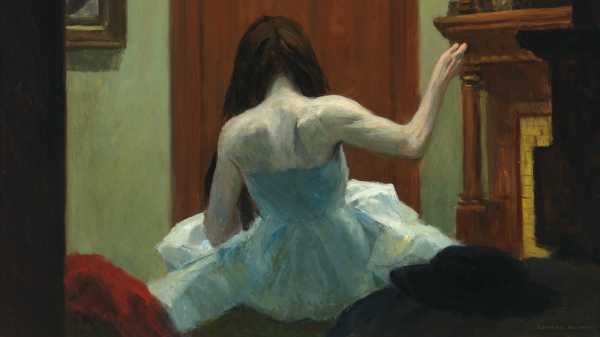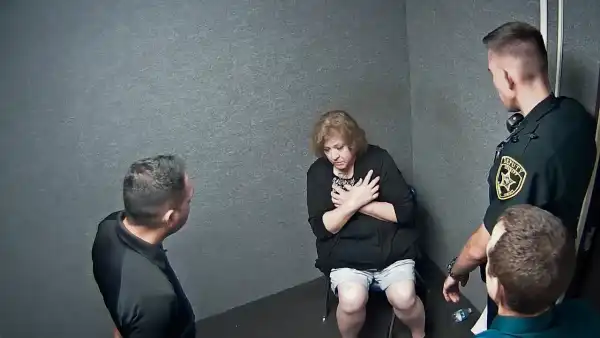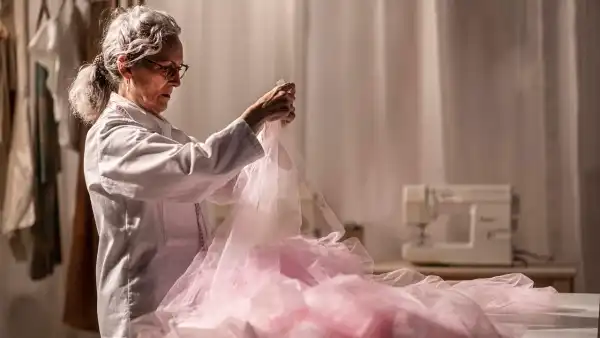
The end of the pandemic in New York has been declared so many times—I have heralded many a false spring myself—and each time with a stumbling, unhappy one-step-forward, one-step-back rhythm, that to declare it over for good feels squishy and dubious, like other declarations of the end of things that, in their nature, may have none: irony, liberal democracy, and the Jets quarterback crisis all being other instances of things that will not end even when we are told that they are over.
And yet a recent November weekend, in the eyes of one newly recovered from a belated (and, luckily, unserious) bout with the virus, seemed to mark, finally, an authentic moment of return—one that could be felt on the streets and even in the subways, where the unmasked now far outnumber those of us still warily, prudentially covered. The return seems self-organized and fuelled as much by willed exasperation as by scientific confidence. With a common, perhaps merely fatalistic defiance, the city’s denizens seem to have decided that, as John Lennon might have said, the pandemic is over if we want it. The lights and windows at Lincoln Center for Paul Taylor’s weekend matinées are shining, and the plaza full; the R train is mobbed again—even if the prevalence of helpless people on the subway and street is unmissable as well—and that strange familiar civic oscillation of ugliness and sublimity has come back, astoundingly intact.
The nucleus of this moment of recovery might be located, however improbably, at the show of Edward Hopper’s paintings of New York, which opened at the Whitney Museum of American Art in October and will persist until March 5th. The show fills an entire floor of the Whitney’s newish headquarters, down near the High Line—a thing whose existence is itself proof that things happen faster in New York than we can imagine. The High Line had been a barbed-wire wilderness, haloed by a forlorn pipe dream to save it, at the beginning of the century, and has now become so familiar an “amenity” that we almost forget about it, or sneer at its pretensions: “The High Line district, indeed!”
The Hopper show is predictably crowded—the Whitney’s spaces, fortunately, are large enough to absorb the crowd—but also unmistakably intense and emotional. One feels the hush and murmur of undivided absorption. Though not every famous Hopper made the trip—“Nighthawks” remains locked in its home in Chicago—most of the favorites are here. New Yorkers are back in the presence of our local pictorial poet, his images still haunting after almost a century of art-historical ferment: the bending woman changing clothes unselfconsciously in a brownstone window, as if glimpsed from the old Second Avenue El; the usherette in bobbed hair leaning half asleep against the wall of the ornately luxurious movie palace; and even such awkward bits of found street poetry as the staid front of an old-fashioned pharmacy, of the kind New York was once filled with, advertising Ex-Lax with equipoise. (We are reminded by these images that one of the nameable losses of the pandemic is movie theatres—long since degraded from their once palatial role, they now seem unlikely even to hang on as the hangars they have become—and also small pharmacies, assimilated into the fluorescent empire of Walgreens.)
Never “dramatic” in the normal sense, unspooling some story, Hopper’s pictures are, as John Updike once said, “models of therapeutic reserve,” deferential to their subjects even as the painter scans their psyches. In the beautiful, early “Night Windows,” of 1928, a woman, headless and seen in half form, bends in her red slip in her brightly lit apartment as we look inside. It is not a provocative but a functional gesture, made sexy only by our fleeting view of it. The opposite of voyeuristic, it is intimate, if only for a second—we are briefly inside the room as we pass by outside. It’s summer in New York: the curtain on the left, puffing out, is the small relief of the breeze she feels, and the ugly baseboard radiator beyond reminds us of the rent she pays. The tripartite division of the bay windows against the darkness gently guys the form of a conventional religious altarpiece, with the figure in the middle, the right wing fiery red and yellow and the left wing filled by a ghostly pneuma—an epiphany glimpsed from the dark. Though Hopper’s images are at times lecherous, they are never leering; instead, desire is sublimated into a kind of reverie. This was the genius for enigmatic parable that separated Hopper’s art from magazine illustration; we empathize with his people, but what we are empathizing with is left unsure. One truth of art is like a truth of taste: truffles and Parmesan are one brief stop away from disgust, and great pictures are often one stop away from illustration or, with abstract ones, from anarchy. It isn’t wrong to say that a Pollock resembles a common drip cloth—the art is made close enough to anarchy to dance with its edge—and Hopper is often just a brisk leap from magazine illustration, because there was, in the magazine illustration of his time, a declared, unassuming interest in the world as it is. We never feel sorry for Hopper’s people; their dreams and isolation are too much like our own.

“Room in New York,” 1932.Art work by Edward Hopper / © Heirs of Josephine Hopper / Courtesy Sheldon Museum of Art / ARS
The mystery and melancholy of a street, De Chirico’s inspired phrase for his premonitory modern painting of city lights and shadows, could be the title of the whole exhibition. Hopper, one sees, was neither a political nor a literary nor even a “cinematic” painter but a theatrical one; the most moving exhibit in the show is of a tidy collection of Broadway-ticket stubs, kept by the Hoppers as souvenirs of playgoing. (One notes, too, that the prices were all in the accessible three-dollar range.) Hopper’s space, his diorama-like proscenium boxes, evokes exactly the stylized realism of the Broadway theatre of his day—naturalistic in intent, but with a realism made wholly of obvious stylizations, dramatic lights, and painted flats. Though Hopper is often credited with having influenced, and in turn with having been influenced by, the dramatic lighting designs of film noir in the forties, in truth his vision depends on the odd and older drama produced by brilliant patches of color caught in dramatic chiaroscuro in a neatly framed space—diagonal slashes of scarlet dress in lamplight, against a dingy brownstone window—of a kind that movies would not conquer until at least the time of “Vertigo.” It is the set designers of Hopper’s era—look at Jo Mielziner’s melancholic, crooked sets for “Death of a Salesman” or “A Streetcar Named Desire”—that share with him a common language, whole houses and back yards squeezed squarely onstage and lit by moody blues and eerie oranges. Stage light and stage sets haunted Hopper’s imagination, and his project, in a sense, was to reproduce from life the intensities of stage design. Hopper peeks in on his subjects as theatergoers do, eager to sit in the dark and see someone else’s drama unfold from a few feet away.
As one walks through the show, various art-crit distinctions and determinations emerge under one’s necessarily patient gaze—as one must do more than even the normal amount of hopping and skipping among the crowd to get a view of each picture. Hopper was a remarkably awkward animator of line, his famous stillness as much accepted as won, the stability of his forms implanted in the limitation of his line. The worst—indeed, almost comically inept—picture in the show is “Bridle Path,” from 1939, in which three horses so wooden as to seem snatched off a child’s carousel lurch and stumble uneasily in Central Park. The awkwardness is not merely limited to the horses but extends all the way through the construction of the picture, as though being impelled to make something in motion induced a reverse line of paralytic panic in the painter. Making things move was not Hopper’s purpose, and it was also not his gift. And one notices that his tender, enlivening touch with light was at its best between the late twenties and thirties, with the pictures from the forties and beyond—with Hopper stubbornly sticking to his mise en scène, as real artists always do—becoming less gracefully lit and more stolidly imagined, in often uneasy, blocky forms, with a more obvious pathos of alienation.
No matter. Someone once said, of Magritte, that it was a blessing that he was not a better painter, since then he would have been a much worse artist—another Dalí, all effects and virtuoso fakery, shallow rather than haunting. Hopper is in many ways our American Magritte: a spy on bourgeois manners, turned into art by his ambivalent attraction to them, and an artist who was lifted, not reduced, by the dignified simplicity of his means. But a deeper, or anyway bigger, question is opened by the show as well. Hopper has always been part of the bad conscience of American modernism. I recall how his beautiful depiction of the usherette, “New York Movie,” used to be hived off to a little hallway of its own at MOMA, not far from the much loved but still more derided Wyeths. It was not shame on the part of the curators, exactly, but uncertainty about where to put Hopper or what to say of him—where he “belonged” in the larger story of the rise of American art and the triumph of American painting, with Hopper sitting uneasily neither in the abstract evolution that led to Minimalism nor in the gayer appropriative one that led to Pop.

“Morning Sun,” 1952.Art work by Edward Hopper / © Heirs of Josephine Hopper / Courtesy Columbus Museum of Art / ARS
Yet if Hopper is part of the bad conscience of American modernism, he is part of the civic consciousness of New York. The magnetic attraction of Hopper to the audience at the Whitney, the hushed and serious note of gazing and approval—producing not at all the annoyed rhythm in which visitors read the wall labels, mutter bits of them to a child or spouse, and then shrug, in a vain effort at understanding what the hell this is—reminds us that, if Hopper is our Magritte, he is our Philip Larkin, too. As Brits love Larkin’s poems, despite the relentless melancholy of his vision—they hear “They fuck you up, your mum and dad” as delightfully candid, not bleak—so New Yorkers love Hopper, despite the relentless melancholy of his. In both of these slightly bearish and conservative artists, perhaps, it is the ability to constrain pleasure in order to evoke it that touches us. Hopper caught that the seeming sadness of city life is also part of its gaiety. Everything about the urban life he shows us is isolated, uncommunal—and yet his images of apparent loneliness seem somehow anything but grim, rather proudly self-reliant. (Times Square, Macy’s—all those gathering places, with New Yorkers as frantic as water bugs when the light goes on, as Florine Stettheimer loved to sing, are nowhere in his work.) We somehow find more credible and—a strange but significant point—more comforting the imagery of isolation than we do that of gathering.
And suddenly a tug on the heart suggests why this exhibition is so crowded and feels so alive: what we missed in the absence of crowds is the opportunity for solitude. Having seen at last an unpeopled New York, we realize now that our best life in this city lies in being unseen in too-seen places, overlooked while others are looking, left alone to become our secret selves. The poets of New York have always known this truth. As Maeve Brennan, this magazine’s Long-Winded Lady, wrote, “New York does nothing for those of us who are inclined to love her except implant in our hearts a homesickness that baffles us until we go away from her, and then we realize why we are restless. At home or away, we are homesick for New York not because New York used to be better and not because she used to be worse but because the city holds us, and we don’t know why.” Perhaps after the pandemic, the homesickness of those so long kept at home radiates through the rooms. The city holds us, and we do know why. ♦
Sourse: newyorker.com






